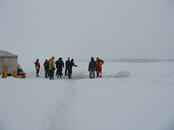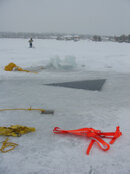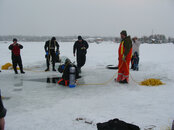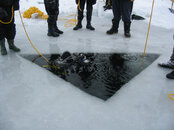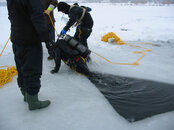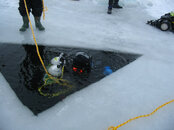We will organize the ice diving at 1850 meters altitude from 31 January to 1 February.Since El Zee still wants to visit this museum, chances are that we will visit Switzerland in the near future.
You are using an out of date browser. It may not display this or other websites correctly.
You should upgrade or use an alternative browser.
You should upgrade or use an alternative browser.
Where did you dive today?
- Thread starter El Orans
- Start date
Please register or login
Welcome to ScubaBoard, the world's largest scuba diving community. Registration is not required to read the forums, but we encourage you to join. Joining has its benefits and enables you to participate in the discussions.
Benefits of registering include
- Ability to post and comment on topics and discussions.
- A Free photo gallery to share your dive photos with the world.
- You can make this box go away
Skookumchuck
Contributor
Barrie, Ontario ice dive. Air temp -6C, my computer said the water temp was 32F, max depth under the ice was 22 ft. Ice thickness 8 inches. Numerous ice fishermen and snowmobilers as background.
Nice turnout of divers for the dive, had several local Barrie folks want to know how crazy we were.
Well organized and lots of fun!
Nice turnout of divers for the dive, had several local Barrie folks want to know how crazy we were.
Well organized and lots of fun!
Attachments
thanksforallthefish
Contributor
Barrie, Ontario ice dive. Air temp -6C, my computer said the water temp was 32F, max depth under the ice was 22 ft. Ice thickness 8 inches. Numerous ice fishermen and snowmobilers as background.
Nice turnout of divers for the dive, had several local Barrie folks want to know how crazy we were.
Well organized and lots of fun!
I agree you guys are CRAZY ... do you always cut a trangle in the ice or do you vary the shape?
I agree you guys are CRAZY ... do you always cut a trangle in the ice or do you vary the shape?
The triangle shape is really easy to get in and out of on the narrower corners....just sit and turn, you're in. To get out, one or two tenders haul you out while you kick and roll.
The best part is looking up at the light and patterns in the ice, and watching the air bubbles collect under the ice like blobs of silvery mercury rolling around under the ice. It looks dark down there when you're staring down from the surface, but under water when your eyes adapt, there's lots of ambient light.
In the second pic, you can see the thickness of the chunks of ice cut out and pulled up, plus the harness you wear under your BC. The small square hole serves as an anchor point for the safety line: a 2 ft piece of 2x4 lumber with a hole through it is tied to the end of the line, then the lumber is pushed down into the hole and floats up under the ice, so the line is anchored. The line gets attached to the harness and the line tender communicates with you through this rope. Plus you can only go as far as the rope is long, and be hauled out if needed. After the dive was done, the pieces of ice were replaced in the hole, snow was shoveled on top and "caution" tape was put around to keep anyone from going through before the ice refroze into place (couple of hours).
In the third pic, the second person from the left is the safety diver, he's also in the last pic.
You have to work fast after the dive to get out of your gear or it freezes onto you and the water the topside crew has heated up comes in useful....
Last edited:
- Messages
- 102,492
- Reaction score
- 106,653
- Location
- On the Fun Side of Trump's Wall
- # of dives
- 2500 - 4999
Did three dives in Hood Canal yesterday. The weather was sunny and calm ("Indian Winter") ... water was glass-flat ... and vis was 30-40 feet (about as good as it gets here).
Lots of happy faces ... even the "locals" were smiling ...
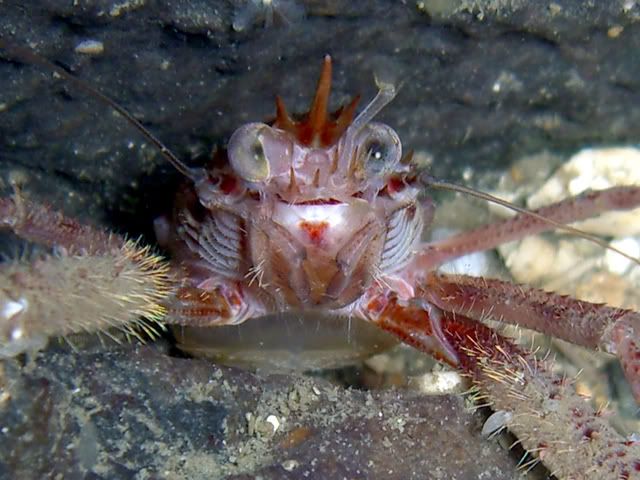
... Bob (Grateful Diver)
Lots of happy faces ... even the "locals" were smiling ...

... Bob (Grateful Diver)
Soakedlontra
Contributor
What a crisp blue sky at Keystone on Sunday, January 18! A surprisingly bright sunshine flooded my eyes with welcoming wintry light and fortified my cranky bones. The mood of the air was peaceful and meditative. The mood of the water was quite the opposite. Pieces of driftwood and other debris were floating in a swirling and churning sea. Like commuters eager to catch a bus back home after a stressful day at work they rushed in a hurry from east to west pushed by a steady ripping current.
There was no doubt about it: today is going to be a drift dive day!
My buddy and I walked all geared up to the pilings and beyond. We were planning to surface swim straight out and let the current do most of the work and drag us to the eastern side of the pilings. Still, we had to kick a little to hit the target.
The rushing current tossed us around like we were weightless. We avoided slamming against the pilings by stretching our arms and holding onto a couple of logs that, by chance, got stuck in the right place at the right time, across between two pilings. But a floating log can be unpredictable and vicious and I wanted to use it as a support no longer that it was necessary. We managed to discuss our dive plan while floating in a watery convulsive pandemonium, where almost everything was fast moving and made us dizzy.
Initially we wanted to submerge there and swim through the pilings, were the current is usually weaker. But it took us less then a second to realize that it was a foolish idea. The current was too strong for our comfort level. All at sudden it became clear that we were in a catch 22 situation. If we submerged on the outer side of the pilings the current would have dragged us south-west away from the beach and into the open sea. If we submerged on the side of the pilings nearer to shore we would have to put up with even a stronger current.
I followed my gut feelings and suggested to head for the side of the pilings nearer to shore. If something went wrong at least we would have to do a shorter swim to the beach. My buddy agreed. So off we went letting our grip on the logs go. When I reached the last piling I embraced it like it was a raft left over from a shipwreck. Its soggy wooden surface was encrusted with sharp barnacles, mussels and soft tube worms. My legs were pushed horizontally by the unforgiving current. I felt like a flag on a stormy day on the verge of getting ripped by a howling wind.
I hung in there waiting for my buddy to get closer determined not to give myself up to the stubborn will of that rushing water. I was rather nervous and the stress level was rising. But when, at last, my buddy was next to me and we let our arms go off those pilings and began to descend while embracing the current rather than that stiff vertical timber and felt that the deeper we went the less current there was dragging us away, I relaxed and began to enjoy the dive with a sense of relief.
We must have drifted by the pilings in a flash, but at that point we did not care anymore. We signed, resigned to the force of Nature and drifted away with it thinking that we would have ended up emerging at the end of the dive somewhere between the pilings ant the jetty. Instead, when our time was over and we had to get out of the water we were right next the boulders of the jetty.
(for an illustrated version of this tale go to :
Open Water Bubbles: Drift Dive at Keystone)
Cheers
There was no doubt about it: today is going to be a drift dive day!
My buddy and I walked all geared up to the pilings and beyond. We were planning to surface swim straight out and let the current do most of the work and drag us to the eastern side of the pilings. Still, we had to kick a little to hit the target.
The rushing current tossed us around like we were weightless. We avoided slamming against the pilings by stretching our arms and holding onto a couple of logs that, by chance, got stuck in the right place at the right time, across between two pilings. But a floating log can be unpredictable and vicious and I wanted to use it as a support no longer that it was necessary. We managed to discuss our dive plan while floating in a watery convulsive pandemonium, where almost everything was fast moving and made us dizzy.
Initially we wanted to submerge there and swim through the pilings, were the current is usually weaker. But it took us less then a second to realize that it was a foolish idea. The current was too strong for our comfort level. All at sudden it became clear that we were in a catch 22 situation. If we submerged on the outer side of the pilings the current would have dragged us south-west away from the beach and into the open sea. If we submerged on the side of the pilings nearer to shore we would have to put up with even a stronger current.
I followed my gut feelings and suggested to head for the side of the pilings nearer to shore. If something went wrong at least we would have to do a shorter swim to the beach. My buddy agreed. So off we went letting our grip on the logs go. When I reached the last piling I embraced it like it was a raft left over from a shipwreck. Its soggy wooden surface was encrusted with sharp barnacles, mussels and soft tube worms. My legs were pushed horizontally by the unforgiving current. I felt like a flag on a stormy day on the verge of getting ripped by a howling wind.
I hung in there waiting for my buddy to get closer determined not to give myself up to the stubborn will of that rushing water. I was rather nervous and the stress level was rising. But when, at last, my buddy was next to me and we let our arms go off those pilings and began to descend while embracing the current rather than that stiff vertical timber and felt that the deeper we went the less current there was dragging us away, I relaxed and began to enjoy the dive with a sense of relief.
We must have drifted by the pilings in a flash, but at that point we did not care anymore. We signed, resigned to the force of Nature and drifted away with it thinking that we would have ended up emerging at the end of the dive somewhere between the pilings ant the jetty. Instead, when our time was over and we had to get out of the water we were right next the boulders of the jetty.
(for an illustrated version of this tale go to :
Open Water Bubbles: Drift Dive at Keystone)
Cheers
Last edited by a moderator:
thanksforallthefish
Contributor
The triangle shape is really easy to get in and out of on the narrower corners....just sit and turn, you're in. To get out, one or two tenders haul you out while you kick and roll.
The best part is looking up at the light and patterns in the ice, and watching the air bubbles collect under the ice like blobs of silvery mercury rolling around under the ice. It looks dark down there when you're staring down from the surface, but under water when your eyes adapt, there's lots of ambient light.
In the second pic, you can see the thickness of the chunks of ice cut out and pulled up, plus the harness you wear under your BC. The small square hole serves as an anchor point for the safety line: a 2 ft piece of 2x4 lumber with a hole through it is tied to the end of the line, then the lumber is pushed down into the hole and floats up under the ice, so the line is anchored. The line gets attached to the harness and the line tender communicates with you through this rope. Plus you can only go as far as the rope is long, and be hauled out if needed. After the dive was done, the pieces of ice were replaced in the hole, snow was shoveled on top and "caution" tape was put around to keep anyone from going through before the ice refroze into place (couple of hours).
In the third pic, the second person from the left is the safety diver, he's also in the last pic.
You have to work fast after the dive to get out of your gear or it freezes onto you and the water the topside crew has heated up comes in useful....
Thanks for that ... very interesting ... have never really thought that much about ice diving. I would have trouble finding ice anywhere near here, and if I did I would steer well clear of it ... I dont like the cold.
As my wife says ... Ice is gods warning sign "Keep Out"
Heh, heh, also in pic #2 there's an ice fisherman in the background...he moved coz we would likely scare the fish.
:shocked2:How do you train your fishermen like that
Actually we do have some nice fishermen here (those are the ones we give lost fishing gear to). Hard to convince some people that...
if we scared the fish there would be no point diving... cause we are there to look at and take pics of the fish
we all want to enjoy the same resource without interfering with each other's right to do what they are legally entitled to do:blinking:
I have a question.... how do you keep your line from tangling with the other diver's line? May be a silly question but I have visions of tangled fishing line or dancing around the maypole!
Similar threads
- Replies
- 11
- Views
- 1,341
- Replies
- 0
- Views
- 74
- Replies
- 0
- Views
- 380




